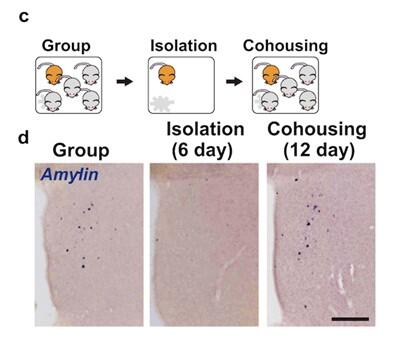Many people have become lonely during the isolation caused by the coronavirus pandemic, and the prevalence of depression and other mental health issues is increasing worldwide. Loneliness (perceived social isolation) is also known to negatively affect physical health and can increase the incidence of cardiovascular disease and cancer. A collaborative research group at the RIKEN Center for Brain Science consisting of Kansai Fukumitsu, Special Postdoctoral Researcher, and Kumi Kuroda, Laboratory Head, discovered a molecular neural mechanism that causes female mice to feel lonely and seek companionship. In the future, this research is also expected to contribute to increased understanding of human solitude and sociality. The findings of this study were published in Nature Communications.
The Kuroda lab has previously identified neurons with calcitonin receptors (Calcr) in the central medial preoptic area (cMPOA) as a brain mechanism required for parenting that is shared by both female and male mice. Especially in mothers, the amount of Calcr increases with the action of female reproductive hormones. By activating the cMPOA neurons necessary for parenting, they show their willingness to protect their offspring, even if it means putting themselves in danger. Calcr is activated by amylin (a neuropeptide) produced by other cells in the cMPOA. During this study, the researchers incidentally discovered that when female mice that lived in groups were kept alone, the expression of amylin in the cMPOA almost completely disappeared. Therefore, they studied the roles of the cMPOA and amylin in adult-to-adult interactions.
The study group first examined the conditions under which the expression of amylin in the cMPOA fluctuated, either by removing one animal from a population cage of 4-5 female mice and placing it in a cage by itself, or by leaving only one other mouse in the cage. In both situations, the number of amylin-expressing neurons in sequestered mice decreased by about half in two days and became nearly zero in six days but returned to the previous level in about two weeks when the mice were returned to group housing. In addition, the number of amylin cells was reduced to 3% or less in five days when the animals were sequestered alone or when the other mice were visible beyond the windowed partition. These results indicate that the number of amylin cells in female mice not only depends on odor and visual stimuli, but also contact with peers.

Courtesy of RIKEN
In terms of behavior, isolated mice were less likely to stay still than grouped mice, and often dug under the windowed partition and examined the area around it. In addition, the time spent chewing the partition by the isolated mice when other mice were visible was 2 to 5 times greater than when they were alone. When other mice were visible, the solitary mice were more willing to chew and break the partition. Two days after quarantine, the partition was replaced with a sham partition with large windows and mice were allowed to move freely. When the isolated mice were combined with others, they actively sniffed and touched the other mice. About an hour after being combined, the mice slept as a group.
The activity of cMPOA amylin cells declined when mice were separated from the population and rose when mice were kept in group housing after separation. Therefore, it seems that amylin cells are activated, and their expressions are maintained, by social contact.
Amylin and other neuropeptides bind to specific receptors on the surface of the plasma membrane and control neuronal activity. The amylin receptor is a complex of Calcr and another protein. In the cMPOA, amylin and Calcr were expressed in different neurons, and neurons expressing Calcr were activated when amylin was administered to the cMPOA or when separated female mice were reintroduced to their peers. To determine whether amylin and Calcr cells in the cMPOA activate simply by physical touch, researchers created a context in which mice faced anxiety/fear.
Mice are nocturnal and feel anxiety and fear in the light. When mice are suddenly exposed to intense light during the night, they alert each other and attempt to protect themselves. At this time, brain sites responsive to anxiety and fear, such as the cMPOA, were activated, but the medial preoptic area was not. Thus, the cMPOA may not simply be activated by physical touch but may also require social interaction.
In order to investigate how amylin and Calcr relate to sociality, researchers generated amylin-Cre transgenic mice and artificially activated amylin cells in the cMPOA using the DREADD method, a pharmacogenetic technique. When compared with the wild type, the tendency of isolated mice to chew fences, i.e., to make contact with peers, increased 4- to 7-fold. Conversely, in knockout mice lacking the amylin gene, the behavior of chewing the window fence under isolation was significantly reduced to 26%. Finally, in knockout mice in which expression of Calcr of cMPOA was reduced to approximately 30% by RNA interference, chewing behavior in isolation was reduced to less than half. These results reveal that signal transduction by the amylin-Calcr neural circuit plays an important part in the behavior of sensing loneliness and trying to reunite with peers.
The research group is currently using common marmosets to investigate whether the amylin-Calcr neural circuit exists in the primate brain region corresponding to the mouse cMPOA, and whether it is involved in parenting and social interaction between adults. These findings are expected to lead to the clarification of the essence of human sociality and its flip side, loneliness.
This article has been translated by JST with permission from The Science News Ltd.(https://sci-news.co.jp/). Unauthorized reproduction of the article and photographs is prohibited.




